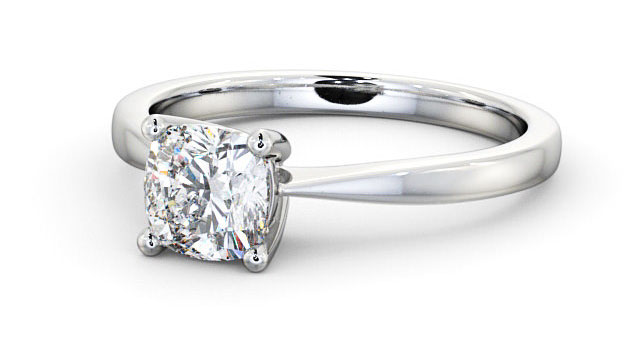DIAMOND SHAPE
A diamonds shape is its most distinctive, unique and easily identifiable characteristic.
Every diamond is one of a kind, just like every person and every person has their preferred shape of diamond.
At Angelic Diamonds we aim to cater for the wishes of all our customers by offering a full range of different shaped diamonds, along with detailed education on each shape.
Shape can be referred to as cut, for example Round Cut or Princess Cut, however, Diamond Cut is not to be confused with Diamond Shape.
The Cut is how well the diamond has been fashioned from the original rough stone. You can see more on Diamond Cut here.
The Shape is the outline of the diamond. Shape provides you with options like that of Round which you are probably a little more familiar with as well as Princess, Oval, Marquise and other Fancy Shapes also.
You can see all of the diamond shapes that we offer here and descriptions of them to follow.
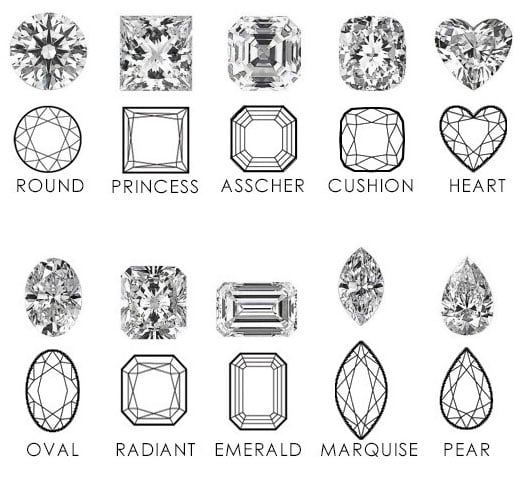
You are the one who gets to see and admire your ring or piece of jewellery every day.
When choosing a diamond shape, make sure you pick something which suits you, something that you like and something that resonates with yourself.
Round Diamonds are by far the most popular but what comes next? You can see below the popularity, in general, of each shape and what percentage they take.

Length to Width Ratio
Length to Width ratio is the comparison of dimensions of a Fancy Shape Diamond. The ratio tells us how long and wide a diamond is when it is viewed from above.
Each fancy shape has a certain length to width ratio that is considered preferred for that particular diamond shape.
We have listed the lowest and highest ratio values we operate between in every description.
However, as always, it does come down to personal preference. So if you have a particular ratio in mind please just get in touch and we can look to source a diamond with your requirements for you.
Length to width ratio is calculated by dividing the length of the diamonds by its width. For example, a Princess shape diamond that is 4.45mm long and 4.40mm wide will have a length to width ratio of 1.01. A diamond with these dimensions will appear perfectly square, this is the case with most Princess, Asscher and Cushion stones that we source however, different shapes, like that of Marquise can be twice as long as they are wide.
Whilst new diamond shapes are being explored and invented all the time, there are 10 main, classic shapes that have really stood the test of time. Let’s dive into those a little deeper now...
Round
The Round diamond is by far the most popular shape with around 60-70% of all diamonds sold being Round.
Round diamonds have been researched more than any other diamond shape so one reason for their popularity is that the Round shape is the most superior in terms of light reflection and brightness, providing an unrivalled sparkle. They are considered to be of ideal proportions maximising brilliance and fire.
Round diamonds also look great in any type of jewellery and go with any outfit; they are extremely versatile and timeless. They are also a really good option if you are unsure of what your partner, or gift recipient, may like.
Nearly all round diamonds are brilliant cut which means they have 58 facets (faces or sides).
You can see some examples of Round diamonds in rings below and you can view our full Round Diamond Engagement ring range here.
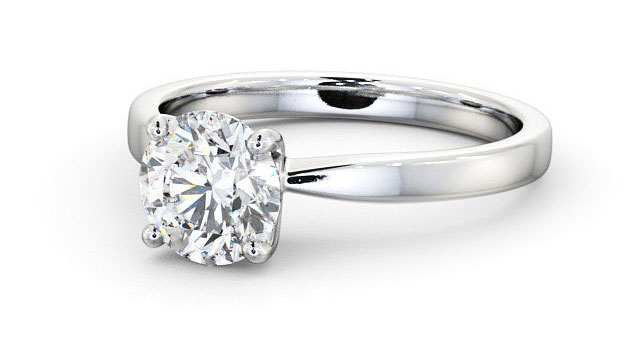
Princess
The Princess diamond is the second most popular shape, second only to the Round.
The Princess diamond has pointed corners and is traditionally square in shape, offering the perfect balance between romantic and modern.
The Princess diamond is an elegant and timeless design that gives a fantastic sparkle. It is a very popular choice for engagement rings.
Having a filled out, square shape, Princess diamonds can look larger than Round diamonds of the same size and will have almost the same amount of sparkle. The placement of a Princess shapes facets makes the diamonds highly reflect and refract light meaning it is often described as the ‘square version of a Round diamond’ having excellent brilliance and fire again.
The most desirable princess diamonds are perfectly square in shape and we keep our Princess diamonds square. The lowest ratio value for diamonds we source is 1:1 and the highest 1:1.05.
You can see some of our beautiful Princess diamond engagement rings below and see all of our Princess Diamond rings here.
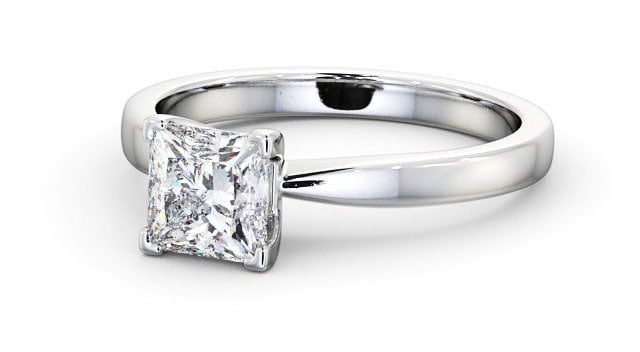
Emerald
Emerald diamonds are usually rectangular in shape. They are clearly distinguished by their cropped corners and step facets.
With Step Cut diamonds the facets are elongated and placed in rows, rather than triangular and kite shaped facets of a Brilliant cut diamonds like that of Round and Princess.
Step Cut diamonds do still sparkle, just in a slightly different way. They are slightly simpler in presentation offering a less cluttered look.
The Emerald diamond has a large open table, thus highlighting any clarity imperfections in the stone. It is therefore important when picking an emerald diamond to consider a higher class of clarity. If you want to guarantee eye-clean we would recommend Clarity VS1 and above for Emerald diamonds. Please do bare in mind also though that as you increase the Carat, that large open table, will get larger also so really large carats may require higher than VS1 Clarity.
Emerald shaped diamonds speak volumes of vintage, and are perfect for people looking for something a little bit more plain or different to the norm.
For Emerald diamonds the lowest ratio value we source is 1:1.25 and the highest 1:1.45.
You can view our full range of Emerald Cut engagement rings here.

Asscher
The Asscher diamond is often referred to as a 'squared emerald'.
The Asscher diamond is exactly the same cut as an Emerald diamond, apart from being square in shape. Similar again to the Emerald diamond, the shape highlights any imperfections, so picking a good clarity is important when selecting an Asscher diamond.
Asscher diamonds give off a real timeless and vintage, Art-Deco feel. They impart a fascinating optical illusions known as the ‘Hall of Mirrors’ effect and offer a sparkle different to any other.
The lowest ratio value for Asscher diamonds we source is 1:1, with the highest being 1:1.05.
Click here to see our Asscher Engagement rings.
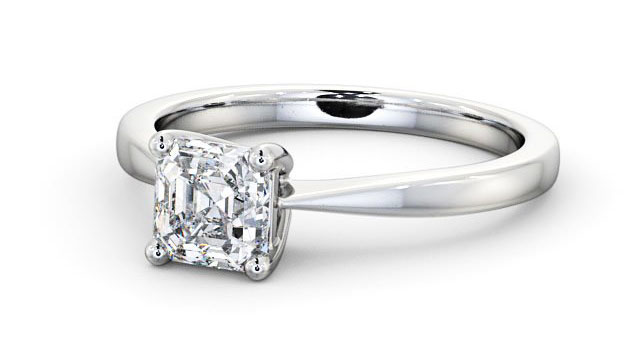
Marquise
The Marquise is a boat shaped, long diamond, with curved sides and pointed ends.
Due to their extended length, Marquise shape diamonds have more size per carat than any other shape, meaning that smaller carat diamonds of this shape can often appear larger.
When set in a ring it can make the finger look long and slender. It looks beautiful when set with round or pear side stones.
Marquise diamonds boast 58 facets making this distinctive shape still sparkle excellently.
For Marquise diamonds the lowest and highest ratio values we operate between are 1:1.70 and 1:2.20.
You can see some examples of Marquise diamonds in rings below and you can view our full Marquise Diamond Engagement ring range here.
The Bow-Tie Effect
When light passes through certain diamonds it can cast a shadow horizontally across some of the central facets. This is what is known as the ‘bow tie effect’ as, like the name states, the shadow looks like a little bow tie.
This is completely normal and can be seen in Pear, Marquise, Oval and Heart Shape stones.
We always minimise the bow tie effect as much as possible by purchasing a diamond with good proportions (depth) but you will always see some form of black line.
If a diamond is cut too deep then the black line will almost disappear but the Diamond will look dull and lack any sparkle so we always try and find the perfect medium.

Oval
The Oval diamond is very similar to the Round diamond. The Oval shape is cut with the same number of facets (58) as the Round diamond so it has a similar look and brightness.
Due to its shape it can make the finger look long and slender. It is the perfect diamond for people who like the Round diamond but prefer a more unusual shape.
Due to its elongated shape, the Oval shape appears larger than a Round diamond of equal carat weight though, making it a great option for optimising your budget.
The lowest ratio value for Ovals we source is 1:1.30 and the highest 1:1.50.
You can see some of our show stopping Oval diamond engagement rings below and see all of our Oval Diamond rings here.
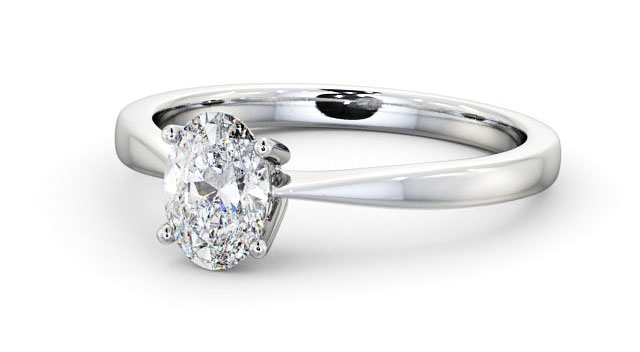
Radiant
Cropped corners are a defining feature of the Radiant diamond.
The Radiant diamond combines the brilliance of a Round diamond and the shape of a Princess or Emerald diamond.
With an intricate 70 facets, Radiant diamonds provide a vibrant and beautiful sparkle, as the name suggests.
Our Radiant diamonds will be between 1:1.15 as the lowest ratio value and 1:1.35 highest ratio value.
Use the link here to see our full range of Radiant’s and check out some of those in the images below too
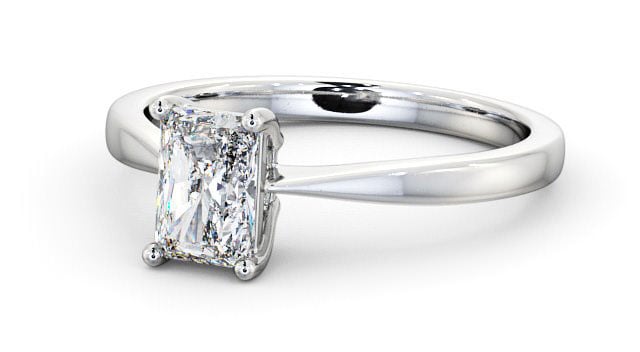
Pear
The Pear diamond is also often referred to as the teardrop, with one rounded and one pointed end. It is the perfect combination of Round and Marquise shapes and cuts.
Its unique shape makes it a popular choice for people looking for something different.
In general, when worn on the finger, the point of the diamond faces away from the hand.
The Pear shape again has 58 facets that set off the natural brilliance and dispersion of the stone.
Pear Halos are a really popular design with us.
For our Pear shapes, the ratios are as follows, lowest ratio value 1:1.35, highest ratio value 1:1.65.
You can see some of our most popular Pears below and use the link here to view more Pear Shapes Diamond rings.

Heart
The Heart shaped diamond is a distinctive shape and the ultimate embodiment of love.
Heart shapes have become as one with love, gestures and affection over the years making them an excellent choice for a birthday, anniversary or of course an engagement ring.
Heart shape diamonds less than 0.50 carat may not be a good choice, as the shape is more difficult to see in smaller stones. Halo or Bezel settings can be good for smaller sizes though as they can really outline and accentuate the shape.
The lowest ratio value for Heart shape diamond we source is 1:0.85, with the highest being 1:1.05.
You can view our full range of Heart engagement rings here.

Cushion
The Cushion diamond is also known as the ‘pillow-cut’ diamond.
The Cushion diamond combines a square cut with rounded corners. It is considered by many to be a more vintage version of the Round diamond.
A Cushion has 58 facets but with those being larger, for the more filled out a square looking shape, they allow for great light reflection and refraction making Cushion diamonds really scintillating stones.
Cushion diamonds possess a character rich antique look and are a favourite with those with like vintage jewellery.
A Cushion diamond with ourselves would have a lowest ratio value of 1:1 and a highest of 1:1.05.
Click here to see our Cushion diamond rings.
